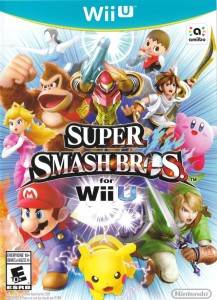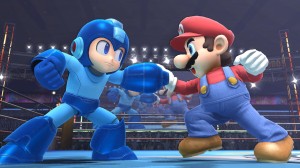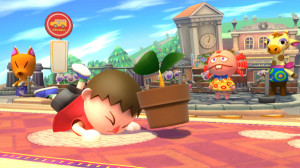Super Smash Bros. for Wii U is not a game that can be properly reviewed after three weeks. It might be a strange way to start a review, but it is also the honest way to start this particular review. Even forgetting that online features will not be available until the public release of the game, Super Smash Bros. for Wii U is a game – like Mario Kart 8 – that has months and even years of play built into its structure. It is a game that – also like Mario Kart 8 – is incredibly easy to start playing but is deceptively difficult to master. Six hour sessions with Smash Bros. with friends feel like just under two hours and three weeks with the game feels like a weekend. While this review will do its best to objectively describe the value of the game based on its mechanics and features, perhaps the most accurate description comes from this bit of – admittedly anecdotal – evidence. This reviewer’s specific pre-release copy of the game hooked back in at least three N64-era elitists, convinced a minimum of two people to buy a Wii U, and logged an approximate total of forty hours of play over three different Wii U consoles and it still feels like a scratch at the surface.
The good thing is that Super Smash Bros. for 3DS provides an accurate enough look at how the controls feel, how the levels look, and how the characters face off against each other. Like many suspected (and even hoped), in comparison, the 3DS version is clearly the inferior one. It will still suffice as an alternate version of the game when console play is impossible and it is still an impressive translation of Super Smash gameplay to a handheld console, but ultimately it serves as either a backup or an appetizer for the main course. The main course is clearly Super Smash Bros. for Wii U.
The game is meant to be played with friends locally (in a perfect world, the online experience would be comparable to this, but not only is that information not currently available, but Nintendo has a clear track record of making online play feel isolating as opposed to uniting) and the difference when playing the game solo is severely felt. In similar fashion to every other Smash Bros. and – once again – in similar fashion to Mario Kart 8, the game feels empty and even a little dull when playing single player. There is a lot to do, but without the thrill of learning to best a human opponent, or even the thrill of taking on event challenges or computer opponents with another person, Super Smash Bros. for Wii U is missing a major ingredient. It is the difference between a largely forgettable one hour experience alone and a group of friends not noticing as hours and hours fly by.
One method of tackling this review could be to list all the modes, describe them briefly, and ascribe some sort of value to them, but that would miss the point of Smash Bros.. Of course there is a lot to do and of course it is all within the range of well-implemented to excellently-implemented with the occasional “what-the-crap-is-that-doing-there” mode thrown in, but these modes are for players to discover on their own and for them to see for themselves what use they will get out of each mode. One exception to this approach is the stage building mode which serves as an auspicious preview to the upcoming Mario Maker and will likely be a component that continues to evolve along with the metagame in competitive play.
I approach the abundance of modes with such flippancy because surface judgments of game modes would miss the point of what is at the heart of Super Smash Bros. for Wii U. Super Smash Bros. for Wii U is equal parts fighting game and party game. More than ever before, the two elements have been expertly welded together. Characters seem to be specifically balanced against either other. While this observation is conjecture, it does line up with what appears to be the game’s strongest competitive claim: to truly excel at Super Smash Bros. for Wii U, a player must learn to master his own character, the characters he plays against, and – ultimately – his opponent.
As exemplified by MMA (a high-level competitive StarCraft II Terran player) crushing Bomber (a high-level competitive StarCraft II Terran player) recently at Blizzcon 2014 despite Bomber’s previously high win record against MMA and staggeringly high win rate percentage in the Terran versus Terran match-up, the best competitive video games are ultimately a match-up of minds. It is a long and difficult struggle to gather and maintain the skill, but to consistently win, a player must out-think his opponent. In this reviewer’s short experience, it would appear that Super Smash Bros. for Wii U has that quality.
In matches that took place in stable levels with no items between two skilled players, a death never occurred because of “bad luck”. Every hit, every KO, every dodge, every jump was intended, precise, and satisfying (or appropriately unsatisfying in the case of misplays). Even more startling is just how well the teams at Sora and Bandai Namco incorporated a character’s “flavour” into his or her strengths or weaknesses. To play well as Charizard, one must become Charizard: Powerful, confident, and determined. To play well as Bowser Jr., a player must begin to feel like a mini-boss from a traditional Mario game: In constant pursuit and always looking to pull out sneaky, but powerful moves to demoralize his opponent. It is a testament to the series as a whole that from such a simple control scheme arises such a creative and varied cast of characters. They are all easy to test out and all difficult to truly master.
In this way, the casual modes are as strong as ever. Choosing a more wild level, turning on items, or upping the number of players to eight adds a frantic, random element to the game which still recognizes enough skill to turn into an intensely fun experience for all those dedicated to winning as well as all those who are just along for the ride.
The Wii U era for Nintendo appears to be one of attempted reconciliation. Super Smash Bros. for Wii U appears to recognize all corners of its audience, including the one that aspires to be an e-sport and including the one that might be intimidated by complexity and does so with only minor compromises to each side. Focusing on mechanics that are easy to pick up and tough to master that are also balanced enough for player skill and mind games to be the most important factors in competitive victory enables Super Smash Bros. for Wii U to build more stable branches out from its deep roots, allowing for a truly impressive variety of play styles that – when necessarily paired with company – make for an addicting, satisfying, and likely incredibly long-lasting experience. Combined with better controller options than the 3DS offers and a bigger screen and better graphics, this is the ultimate Super Smash Bros. game. Do not expect to stop hearing about this game any time soon.
Full disclosure: the author was provided with a free copy of the game for review purposes. This review does not include coverage of online features or the online experience which will become available 36 hours after the time of this writing.


